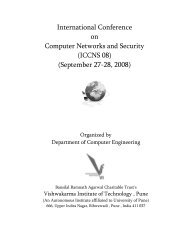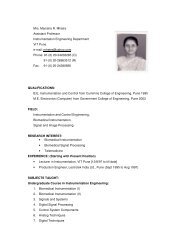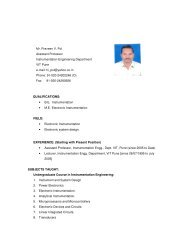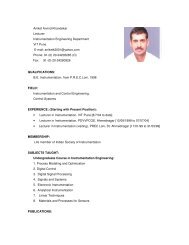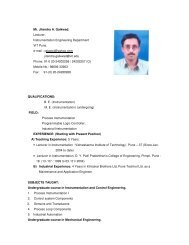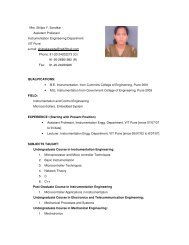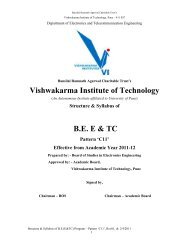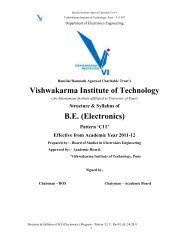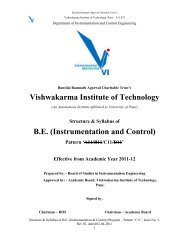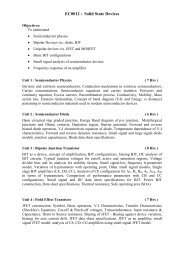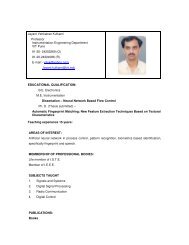Vishwakarma Institute of Technology Master of Computer ...
Vishwakarma Institute of Technology Master of Computer ...
Vishwakarma Institute of Technology Master of Computer ...
You also want an ePaper? Increase the reach of your titles
YUMPU automatically turns print PDFs into web optimized ePapers that Google loves.
BRACT’S<br />
<strong>Vishwakarma</strong> <strong>Institute</strong> <strong>of</strong> <strong>Technology</strong>, Pune – 411 037<br />
Department <strong>of</strong> <strong>Computer</strong> Engineering<br />
Unit II (9+2Hrs)<br />
UML 2.0, Interfaces and Application <strong>of</strong> UML<br />
A. Programming In Small Versus Programming In Large, Overview <strong>of</strong> Model Driven<br />
Development, Introduction to Model Driven Architecture: MDA Terms and Concepts,<br />
Model Mappings, Marking Models, Executable Models, MOF and XMI, Introduction to<br />
UML Metamodel, Extensibility Mechanisms and its usage, Introduction to OCL , UML<br />
2.0 Diagram set , Packages and interfaces: Distinguishing between classes/interfaces,<br />
Component and deployment diagrams: Describing dependencies, Deploying components<br />
across threads, processes and processors<br />
B. Exposing class and package interfaces, Subscribing to interfaces , UML 2.0 in<br />
Application Engineering: Application <strong>of</strong> UML in Embedded System, Application <strong>of</strong><br />
UML in Web Engineering, Forward Engineering and Reverse Engineering Concepts,<br />
Comparison <strong>of</strong> Feature sets <strong>of</strong> UML 1.4 and 2.0 versions<br />
Unit III (9+2 Hrs)<br />
The Behavioral Model<br />
A. Use Cases: Use Cases, Use Case Diagram Components, Use Case Diagram, Actor<br />
Generalization, Include and Extend, Template for Use Case Narrative, Using Use Cases<br />
Domain Analysis: Top View - The Domain Perspective, Data Dictionary: Finding the<br />
Objects, Responsibilities, Collaborators, and Attributes, CRC Cards, Producing<br />
Requirements Models, Capturing system behavior in use cases: Finding primary and<br />
secondary use cases , Include and Extend dependencies, Use case generalization<br />
relationships, Refining use cases: rapid prototypes<br />
B. Class Models and Use Case Models, Judging the Domain Model, Creating the domain<br />
object model: Building a class description database, Finding analysis classes, Managing<br />
Unit IV (9+2 Hrs)<br />
Object Analysis<br />
A. Use case realization: Sequence diagrams, object lifelines and message types, Modeling<br />
collections multiobjects, Refining sequence diagrams, Tying object and behavioral<br />
models with collaboration diagrams, Implementing memory in objects using state<br />
machines: States, events and actions Nested machines and concurrency, Converting<br />
sequence diagrams into communicating state machines, Modifying the object model to<br />
facilitate states<br />
B. Analyzing object behavior: Modeling methods with activity diagrams, Activity<br />
Diagrams: Decisions and Merges, Synchronization, Drilling Down, Iteration, Partitions,<br />
Parameters and Pins, Expansion Regions, Swimlanes, concurrency and synchronization<br />
Other Behavioral Diagrams: Communication Diagram, Interaction Overview Diagrams<br />
Timing Diagrams<br />
Structure & Syllabus <strong>of</strong> MCA Pattern C11, issue 03, Rev 01 Dt 2/4/2011<br />
6





